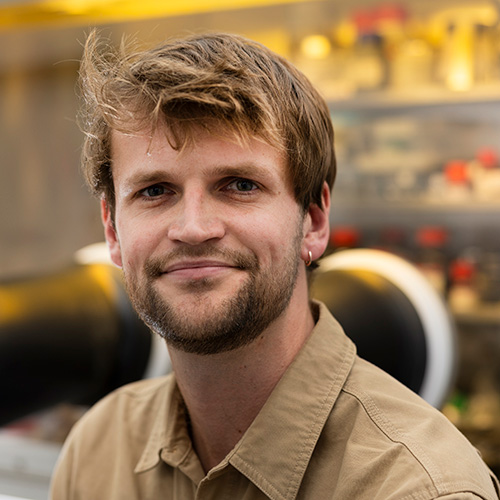Key details
Dr James Le Houx
Senior Lecturer in Materials Science and Engineering
Dr James Le Houx is a Senior Lecturer in Materials Science and Engineering whose research focuses on creating the next generation of 'smart' scientific instruments by integrating artificial intelligence directly into the experimental process. His vision is to build 'self-driving microscopes', autonomous platforms that can intelligently hunt for rare and unpredictable events, such as the microscopic origins of battery failure. By teaching an instrument to predict where and when a flaw will form, his work aims to capture these critical processes with unprecedented detail. This research is grounded in his experience developing novel characterisation techniques at UK national facilities, including the Diamond Light Source and ISIS Neutron and Muon Source. He is currently the inaugural Faraday Institution Emerging Leader Fellow, a role in which he helps shape national battery research strategy.
Dr Le Houx is also the creator of OpenImpala, an open-source simulation package used to model complex 3D data from advanced imaging experiments. Before joining Greenwich, he was a Beamline Scientist at the Diamond Light Source and a Design Engineer in motorsport. He is a Chartered Engineer and holds a PhD and an MEng from the University of Southampton.
Responsibilities within the university
- Supervisor for PhD students.
- Project Supervisor for 3rd year (BEng) and 4th year (MEng) students.
- Core Member of the M34Impact research group.
Awards
Faraday Institution Emerging Leader Fellowship (2024-2027) : A nationally-competed fellowship for salary support over a three-year term, focused on leading battery research across UK national facilities like ISIS and the Diamond Light Source.
Recognition
Fellowships and Professional Standing
- Faraday Institution Emerging Leader Fellow (2024-2027)
- Chartered Engineer (CEng), Institution of Mechanical Engineers (IMechE)
- Member of the Royal Microscopical Society (RMS)
- Member of the American Chemical Society (ACS)
Conference and Peer Review
- Invited Session Chair, American Chemical Society (ACS) National Meeting.
- Conference Co-chair, Institute of Physics (IoP) Image-Based Simulation for Industry (IBSIM-4i).
- Invited Co-chair, Royal Microscopical Society (RMS) Microscience Microscopy Congress (mmc).
- Secretary for the Diamond Light Source Imaging Peer Review Panel (2021-2023).
- Committee Member for the Faraday Institution Early Career Researchers (ECR) group and Scientific Programme Board Member for the main conference.
Research / Scholarly interests
My research is focused on developing new methods for scientific discovery by integrating artificial intelligence directly into the experimental process at national facilities. My long-term goal is to build 'self-driving microscopes', autonomous instruments that can intelligently find and capture the rare, unpredictable events that are currently hidden from view. A key part of my work involves pioneering and deploying novel operando characterisation techniques at synchrotron sources. This includes leading the world's first in-situ dark-field X-ray microscopy experiments for battery research and developing new correlated imaging and diffraction methods. While my primary application is understanding chemo-mechanical failure in solid-state batteries, these advanced, transferable methods are applied to a diverse range of scientific challenges. This includes quantifying the biomechanics of root growth in soil, studying CO2 absorption for carbon capture, and investigating brine freezing to understand the formation of icy moons. This work is underpinned by the development of open-source, high-performance computational tools, such as the OpenImpala solver, for rapid, image-based simulation. Ultimately, my aim is to create and disseminate robust, AI-driven workflows that can accelerate discovery across a wide range of fields, from energy and environmental science to biomechanics and planetary science.
Key funded projects
Faraday Institution Emerging Leader Fellowship
- Dates: 2024–2027
- Amount Awarded: £407,000
- A personal fellowship awarded to lead the UK's national battery research strategy across facilities at the Rutherford Appleton Laboratory. This project is currently active.
STFC Ada Lovelace Centre Grant (CANVAS-nxTOMO)
- Dates: 2021–2022
- Amount Awarded: £147,706
- This grant funded a full-time postdoctoral research position at the Diamond Light Source. The key result was the development and dissemination of an automated, on-site pipeline for the reconstruction, segmentation, and simulation of tomographic data for beamline users, using OpenImpala.
Faraday Undergraduate Summer Experience (FUSE) Grant
- Dates: 2025
- Amount Awarded: £4,166
- Summary: Funding secured as Principal Investigator to mentor an undergraduate research intern, to review the in-situ electrochemical cells developed across the Rutherford Appleton Laboratory.
Peer-Reviewed Synchrotron & Neutron Beamtime (Multiple Projects)
- Dates: 2021–Present
- Amount Awarded (In-Kind): Approximately £1.7M
This represents the combined in-kind value of 9 successful projects as Principal Investigator at national and international synchrotron facilities (e.g., Diamond Light Source, PSI).
